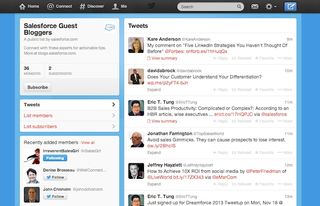As a social media person, I get asked all the time about the social media tools I use and which ones are the best. Especially right now when everyone is saying that engagement on Twitter is down. I really don’t believe this to be true. Like all social platforms, everything is cyclical. But more importantly, you get out of it what you put into it. With that said, hands down, one of my favorite social networks is Twitter. As a public network, it drives real time conversations, and it is much easier to move relationships from cold to warm quickly. For a new, social-savvy generation of salespeople looking for ways to shorten the sales cycle, this can mean big business.
Much like offline conversations, Twitter is at it’s best when it’s not a one-way communication channel. Especially for any size business to be able to use lists and track or engage their prospects, it can be one of the most powerful tools you use. But in order to make it work, you have to engage. This poses a real challenge of sifting through the one billion tweets generated every two days to find the areas and people that matter to you.

There is no possible way for me to track my 100k followers on Twitter and every conversation, nor should I need to. I’ve built up all kinds of lists that allow me check in on the ones that make themselves known to me, stand out with great content, or are people/brands I’d like to get to know.
Here are four steps to how you can create and use Twitter lists to maximize engagement, nurture your relationships and grow your sales initiatives.
1. Create Lists
Go to your profile page and click “lists” to set up as many new lists as you want (however don’t overcomplicate this with too many lists to start. I suggest starting with four to five lists, and taking them for a spin.) For example, I have one list of people called, “Get to Know.” It’s a wish list that allows me to really see and engage with people on their tweets, not expecting them to come to me.
Lists allow you to see a stream of tweets from just the people on each list, seriously editing down the information you want to see. It’ll take some time adjusting it until you have the people you want and the information that is interesting to you, but you’ll be delighted to find tweets you’d never see before that would normally get lost in the Tweet river.
2. Choose Public or Private
Choosing to make a list private vs public is a very important feature as it allows you to control the privacy settings of these lists. I recommend going private at first. Remember, once you set up a public list, people are able to see the list you have built. Often times public lists are important when you want to let others know they are important to you, because they will be notified in their feed when they’re added to any public list.
3. Actively Listen
Lists help you see, hear and listen to your potential audience and take part in their conversations by sharpening your active, social-listening ability. They edit out the noise, giving you the benefit of better understanding and learning of how each person prefers to engage. Active listening by definition happens when you engage with someone after really hearing what they are saying.
4. Engage and Edit More
As you engage with your audience, your Twitter lists should start to define themselves further, helping you sort them into more specific categories. For instance, one person may start to engage with different interests that you hadn’t originally intended. If people are working hard at engaging with you in a two-way conversation, categorize them somewhere that helps you keep the dialogue going with others of similar interests. Engaging helps to amplify your content much faster with more reach, and others tend to be happy to help – but only if the conversation is relevant.
Key Takeaway:
Twitter lists are the social equivalent of an intimate dinner party with your close friends. Narrow down the guest list and forge relationships with prospects and influencers in an authentic way, and shorten your sales cycle by sharing conversation instead of pushing product to an uninterested audience.
__
This post was brought to you by IBM for Midsize Business and opinions are my own. To read more on this topic, visit IBM’s Midsize Insider. Dedicated to providing businesses with expertise, solutions and tools that are specific to small and midsized companies, the Midsize Business program provides businesses with the materials and knowledge they need to become engines of a smarter planet.





